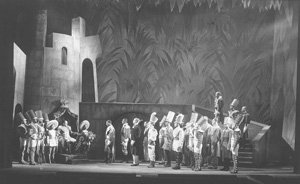talking history | syllabi | students | teachers | puzzle | about us
The New Deal Stage: Selections from the Federal Theatre Project, 1935–1939
http://memory.loc.gov/ammem/fedtp/fthome.html
Created and maintained by the Library of Congress National Digital Library Program, Washington, D.C.
Reviewed Sept. 26–28, 2005.
This Web site is another wonderful addition to the Library of Congress’s American Memory series. While the site highlights three plays that were performed by the New Deal’s Federal Theatre Project (FTP), it also contains a wide array of FTP playscripts and administrative records. Together, these documents provide a broad glimpse not only into the inner workings of performances themselves but also into the federal apparatus that constantly debated their meaning and execution. Containing everything from rehearsal schedules to advertisements to costume designs, this site provides a great deal of breadth for those interested in these experimental theater productions.

Photographic print from New York production of Macbeth
April 14 - June 20, 1936
New Lafayette Theatre
Directed by Orson Welles for the Federal Theater Project
Materials for William Shakespeare’s Macbeth, Christopher Marlowe’s The Tragical History of Dr. Faustus, and Arthur Arent’s Power are exhaustive, as the production notebooks featured on the site offer musical scores, lighting designs, set designs, and playscripts. For each of these shows, the site includes production materials for at least six different performances. In addition, the sixty-eight other playscripts that have been digitized are an incredible resource for those scholars and students researching New Deal culture. Although many of the scripts are “clean” and without notations, there are several that provide comments, allowing viewers to get a sense of artistic intentions and revisions. The Macbeth scripts that are “adaptations for the Colored Unit” invite a comparison with those scripts intended for white actors. In general, the volume of scripts allows Web visitors to investigate how the same performances differed across regions, and, with a virtual representation of the printed page, visitors can also begin to understand how structural elements became altered both according to the site of performance and over time.
The Administrative Records and Production Records are a sampling from the larger FTP collection held at the Library of Congress. These documents range from memos delivered by FTP director Hallie Flanagan to radio broadcast schedules, to materials involving vaudeville, children’s theater, and the Yiddish Repertory. Although these digitized materials would not provide enough information for extensive research on administrative undertakings, they certainly offer visitors a context for further exploration. And the site’s section entitled “Collection connections” is quite useful, as it links the three major sections of the site. Here, Web visitors can understand productions in a fuller sense, examining the administrative goals, play texts, and audience information holistically.
Although the site is not yet searchable, as some of the other American Memory sites are, it is still easy to navigate and the materials are organized cohesively. The site does provide background on the development of the FTP, but it does not evaluate the project more extensively in the context of the other art projects and the larger sense of New Dealers' cultural ambition. And although the site centrally features the “voodoo” Macbeth, it doesn’t offer any more insight into other activities of the Negro units. With a very limited bibliography buried in the “Collection connection” section and without links to other relevant sites, visitors might leave The New Deal Stage with a narrow sense of the Federal Arts Project. Still, the documents featured here are a gold mine for cultural historians, and the site is a good start in making the New Deal’s cultural experiment accessible to a wider public.
Lauren Rebecca Sklaroff
University of South Carolina
Columbia, South Carolina
